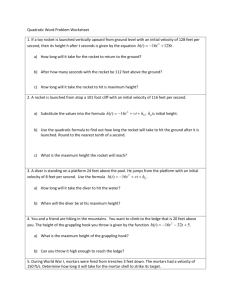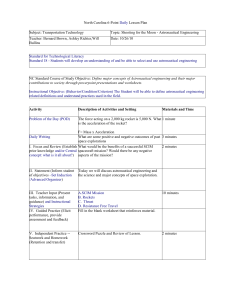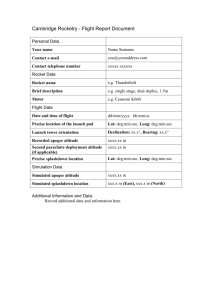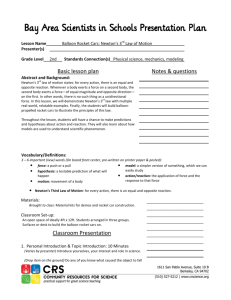Extreme Environments - Rocket science
advertisement
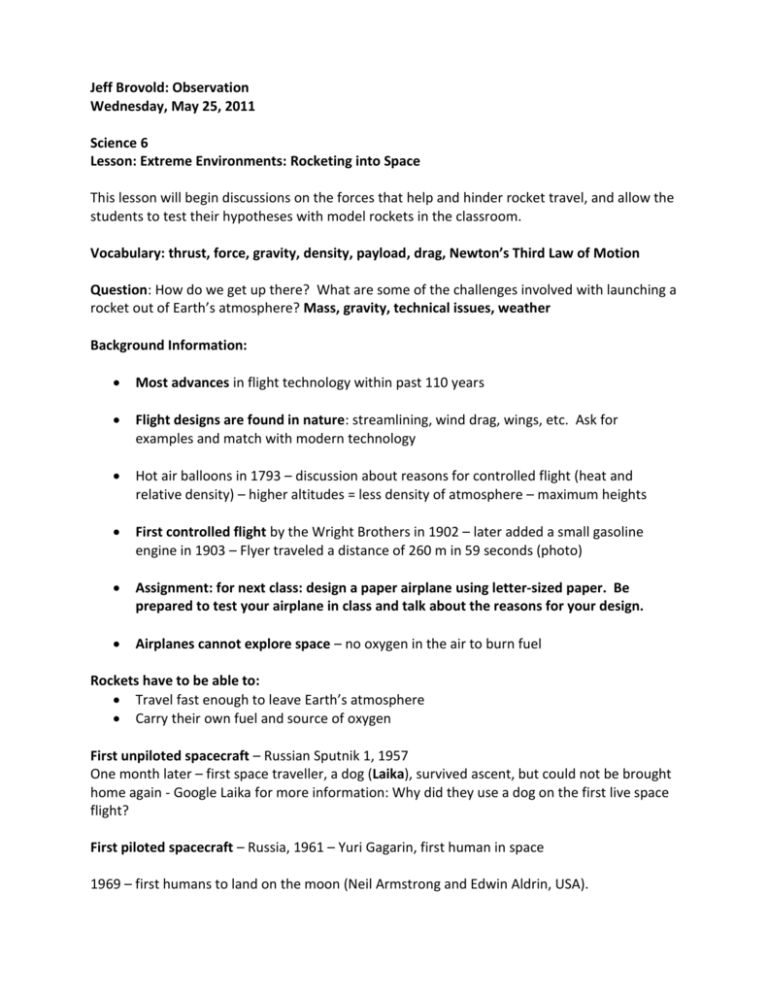
Jeff Brovold: Observation Wednesday, May 25, 2011 Science 6 Lesson: Extreme Environments: Rocketing into Space This lesson will begin discussions on the forces that help and hinder rocket travel, and allow the students to test their hypotheses with model rockets in the classroom. Vocabulary: thrust, force, gravity, density, payload, drag, Newton’s Third Law of Motion Question: How do we get up there? What are some of the challenges involved with launching a rocket out of Earth’s atmosphere? Mass, gravity, technical issues, weather Background Information: Most advances in flight technology within past 110 years Flight designs are found in nature: streamlining, wind drag, wings, etc. Ask for examples and match with modern technology Hot air balloons in 1793 – discussion about reasons for controlled flight (heat and relative density) – higher altitudes = less density of atmosphere – maximum heights First controlled flight by the Wright Brothers in 1902 – later added a small gasoline engine in 1903 – Flyer traveled a distance of 260 m in 59 seconds (photo) Assignment: for next class: design a paper airplane using letter-sized paper. Be prepared to test your airplane in class and talk about the reasons for your design. Airplanes cannot explore space – no oxygen in the air to burn fuel Rockets have to be able to: Travel fast enough to leave Earth’s atmosphere Carry their own fuel and source of oxygen First unpiloted spacecraft – Russian Sputnik 1, 1957 One month later – first space traveller, a dog (Laika), survived ascent, but could not be brought home again - Google Laika for more information: Why did they use a dog on the first live space flight? First piloted spacecraft – Russia, 1961 – Yuri Gagarin, first human in space 1969 – first humans to land on the moon (Neil Armstrong and Edwin Aldrin, USA). Since then, many spacecraft have reached other planets and the far reaches of our solar system, and have landed scientific equipment on Venus and Mars. First reusable spacecraft – Space Shuttle, USA Rocket technology: (Demonstrate balloon pinwheel, ask how Newton would explain its behaviour) Rocket has an opening at one end Engine mixed fuel with oxygen Quick release of gases through the opening creates an upward force – THRUST – on the rocket Related to Newton’s Third Law of Reciprocal Actions – for every action, there is an equal and opposite reaction – the force of the burning fuel pushes the rocket in the opposite direction Thrust must exceed the force of gravity and DRAG (air resistance) in order for the rocket to rise. PAYLOAD is another name for anything that is launched into space. What are some other factors that could affect the speed of the rocket? Aerodynamics, weather THRUST LAB Question: How can we replicate a rocket launch using a balloon? Apparatus: round 13” balloons fishing line transparent tape tag paper drinking straws Method: Students work in groups of four. They will discuss and come up with a plan to launch an inflated balloon (payload) to the greatest height along a taut vertical piece of fishing line attached to the ceiling (which we will refer to as “Earth’s atmosphere”). The goal is for the balloon to reach the ceiling with the greatest force. Students may decide to attach fins to the balloon or not. They will also pre-determine the degree of inflation before launch. The straw will be attached to the balloon, and the fishing line will be threaded through the straw so that the inflated balloon will be situated vertically, on the floor, pointed towards the ceiling just prior to launch. Students will observe and record the flight data for each balloon, make adjustments, and then make a second attempt. Results: What would you say are the characteristics of the most successful balloon rockets? What happened when you made your adjustments to the rocket? How can you explain your results using Newton’s Third Law? << Wright Brothers’ Test Flight in their glider, 1902 Wright Brothers’ gas-powered Flyer, 1903 Saturn V (119 000 kg), Space Shuttle (24 400 kg), Ares I (25 000 kg) and Ares V (130 000 kg) to low Earth orbit Laika, 1957




